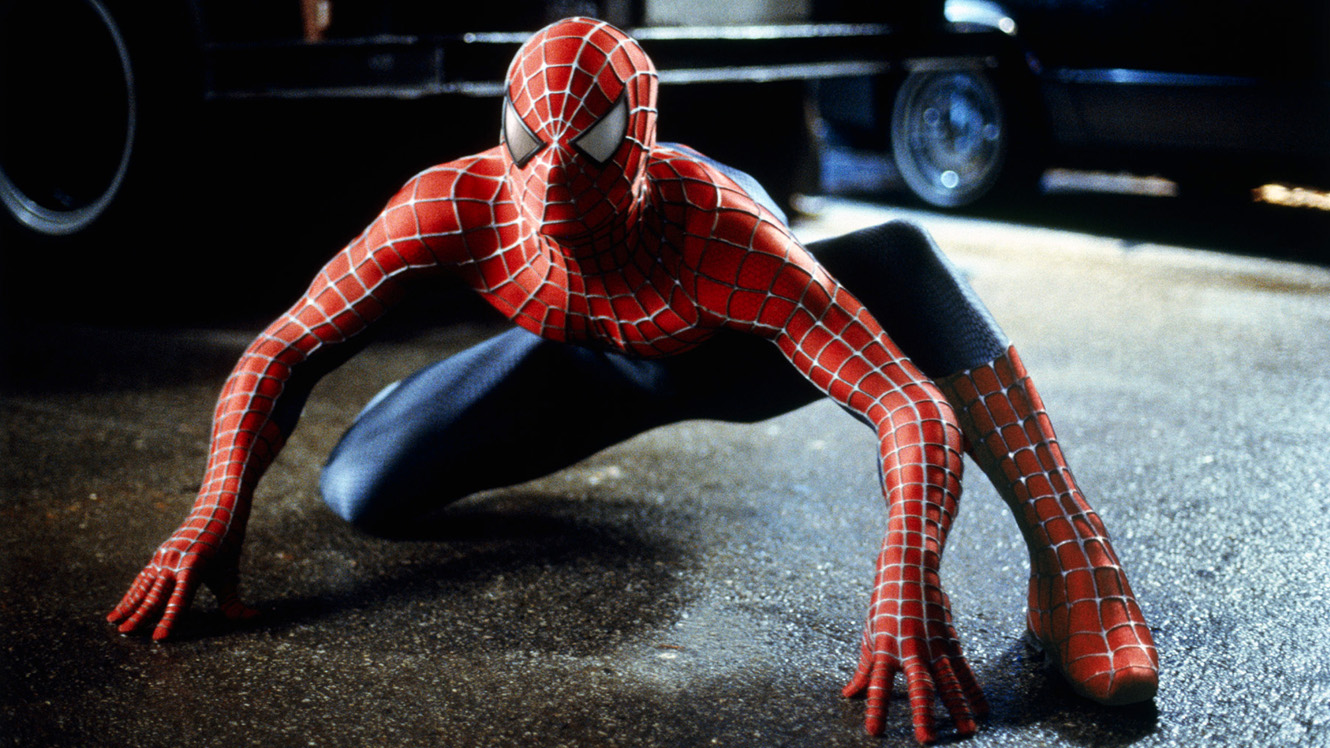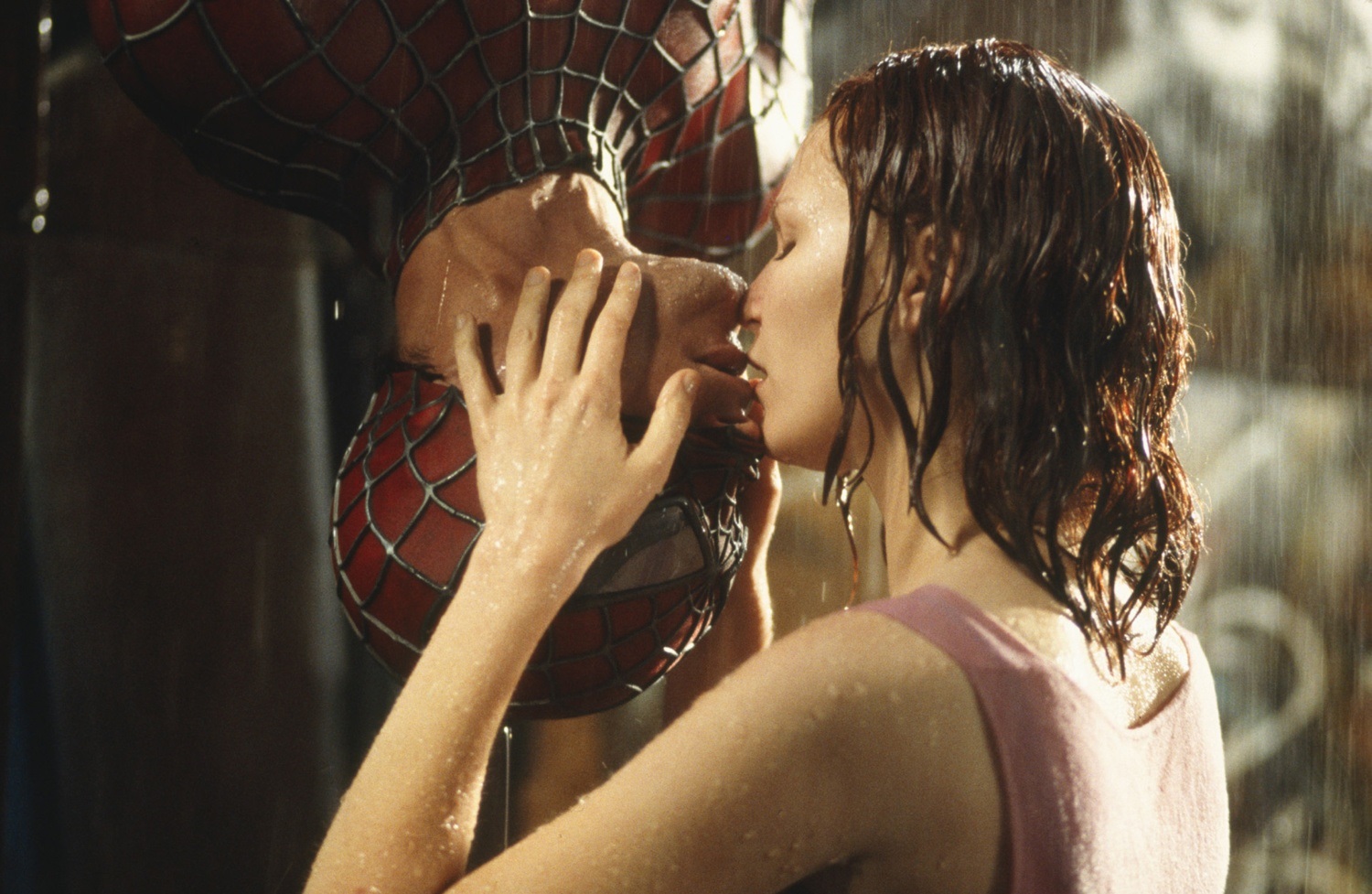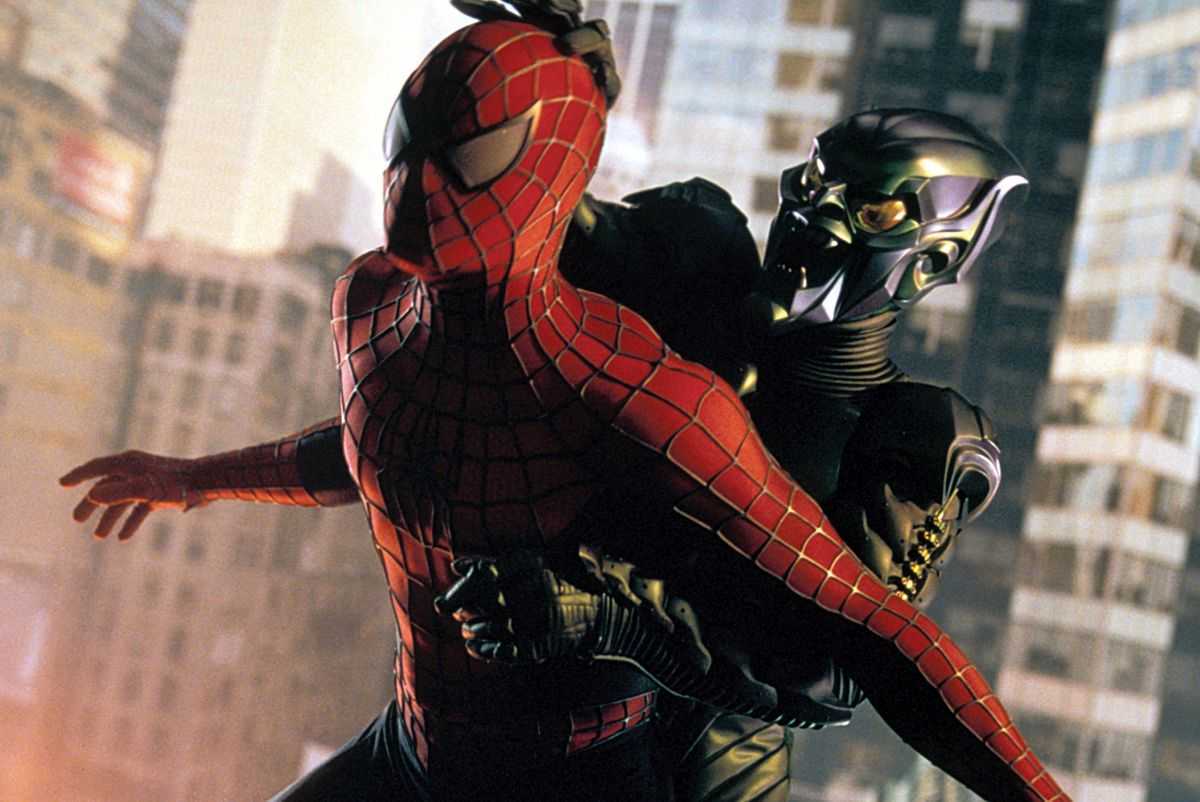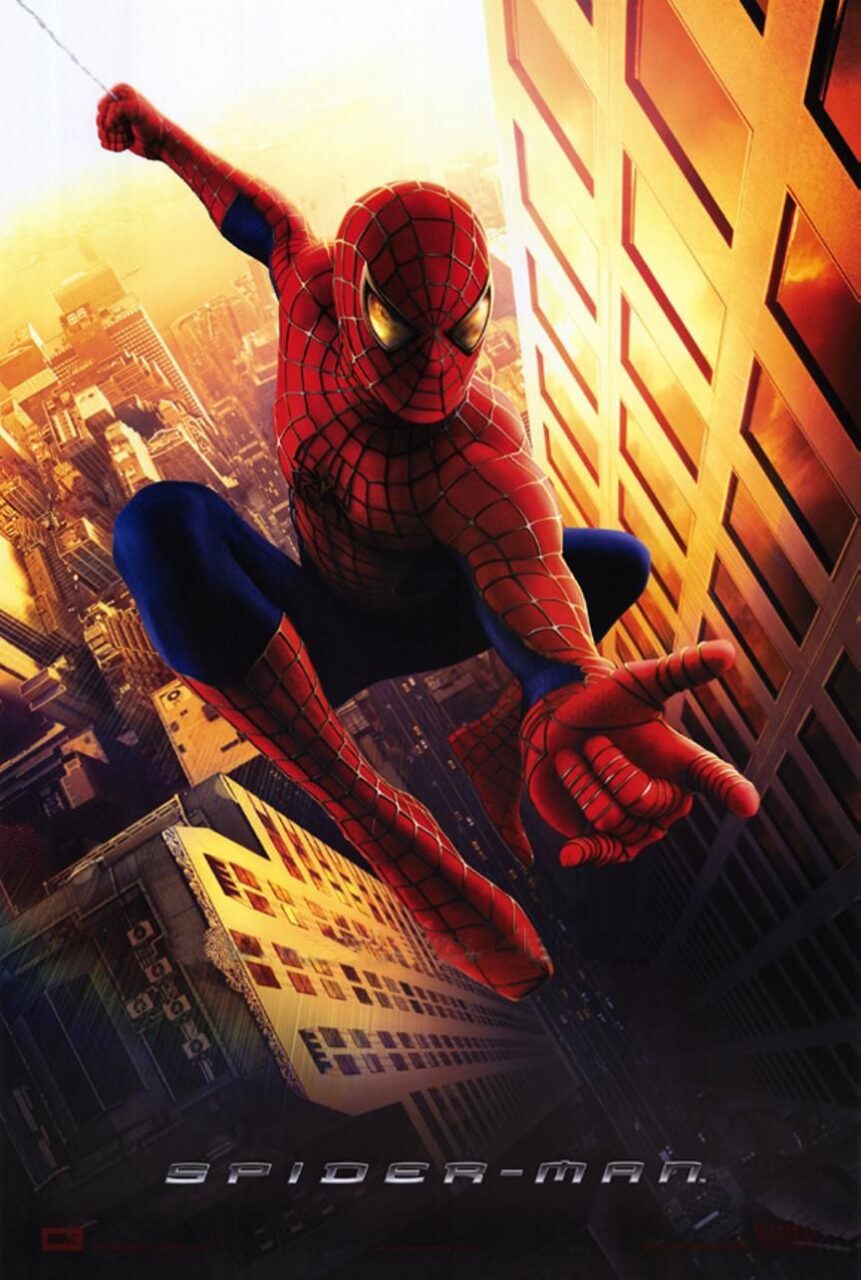USA. 2002.
Crew
Director – Sam Raimi, Screenplay – David Koepp, Based on the Comic Book Created by Steve Ditko & Stan Lee, Producers – Ian Bryce & Laura Ziskin, Photography – Don Burgess, Music – Danny Elfman, Visual Effects Supervisor – John Dykstra, Visual Effects – Sony Pictures Imageworks (Supervisor – Karen Goulekas), Additional Visual Effects – Digiscope (Supervisor – Brad Kuehn) & Pixel Magic, Special Effects Supervisor – John Frazier, Production Design – Neil Spisak, Costume/Mask Design – John David Ridge, Additional Costume/Mask Design – Amalgamated Dynamics (Supervisors – Alec Gillis & Tom Woodruff Jr). Production Company – Marvel Enterprises/Laura Ziskin.
Cast
Tobey Maguire (Peter Parker/Spider-Man), Kirsten Dunst (Mary Jane Watson), Willem Dafoe (Norman Osborn/The Green Goblin), James Franco (Harry Osborn), Rosemary Harris (Aunt May), Cliff Robertson (Ben Parker), J.K. Simmons (J. Jonah Jameson), Joe Maganiello (Flash Thompson)
Plot
Teenager Peter Parker is a constantly bullied nerd and lives with an unrequited love for his next-door-neighbour Mary Jane Watson. One day on a class tour of the research laboratories at Columbia University, Peter is bitten by a genetically engineered spider. He undergoes a strange transformation to find that he now has extraordinary strength and agility and the spider-like abilities to climb walls and fire webbing from his wrists. After a car-jacker kills his Uncle Ben, Peter dons a blue and red masked costume and takes to fighting crime as Spider-Man. He is able to photograph his activities and sells these to J. Jonah Jameson, editor of The Daily Bugle, although Jameson wilfully prints headlines portraying Spider-Man as a freak and criminal. At the same time, billionaire industrialist Norman Osborn, the father of Peter’s best friend Harry, under pressure to develop a power suit for a military contract, injects himself with an experimental fluid and emerges with strange powers. His mind fractured, Osborn adopts green armour and goes on an orgy of devastation where he is nicknamed The Green Goblin by Jameson. Realising that Spider-Man is the only one who can destroy him, Osborn sets out to destroy Peter.
Spider-Man is unquestionably the most famous of all Marvel Comics superheroes. Spider-Man first appeared in Amazing Fantasy #15 in August 1962, created by artist Steve Ditko and written by Stan Lee, the editor responsible for the crafting of the Marvel style and the creation of most of their superheroic pantheon. Though Spider-Man only appeared in one of several stories in that particular issue, the reader response was overwhelming and the character was soon spun off into his comic-book, The Amazing Spiderman. Within only a matter of years, Spider-Man had become Marvel’s most popular character and was being published in at least four simultaneous lines of titles, as well as being spunoff in various animated tv series, children’s shows, records and toy lines.
Spider-Man followed the dictum that Stan Lee demanded of all his superheroes – that they be superheroes that faced real world problems. Spider-Man’s world-shattering battles with the Green Goblin and Dr Octopus would be beset by a cold, Aunt May’s health problems or having to meet an essay deadline the next day at school. In the very first story we met Spider-Man, an episode faithfully recreated in the film here, he exhibits disinterest in helping apprehend a petty hood, only for the same hood to then kill his Uncle Ben.
Spider-Man has often been in the eye of the media, with at least three different animated tv series made at various points between the 1960s and 1990s. Spider-Man even appeared as a live-action character in the children’s educational tv series The Electric Company between 1974 and 1977, where he was played by Danny Seagren. The character was incarnated in a live-action tv series The Amazing Spiderman (1977-9), which only lasted for one season. The Amazing Spiderman series was clearly trying to capitalize on the popularity of various superhero tv series of the era – The Six Million Dollar Man (1973-8) and Wonder Woman/The New Adventures of Wonder Woman (1975-9). There Spider-Man was played by Nicholas Hammond in a series of drearily dull adventures fighting against various petty hoods – but never any super-villains – in routine crime dramas. Audiences outside the United States had the pilot episode served up to them in theatres as Spider-Man (1977) and then had to endure two further cinematic releases, Spider-Man Strikes Back (1979) and Spiderman and the Dragon’s Challenge (1980), recut from episodes of the tv series.

Ever since the tv series, Spider-Man has been tossed around as a big-budget cinematic feature. It was taken up as a property by Roger Corman’s New World Pictures, who had purchased many Marvel Comics properties, and a version was planned in the 1980s. (Corman and New World also produced a low-budget version of Marvel’s The Fantastic Four (1994), which still remains officially unreleased because of legal complexities over the long-planned big-budget Fantastic Four [2005]). The rights passed back and forward between New World and Menahem Golan and Yoram Globus’s Cannon Films, producers of numerous Chuck Norris and Charles Bronson action films and one very cheap comic-book superhero adaptation Superman IV: The Quest for Peace (1987). Various directors had been attached to the project – everybody from Tobe Hooper of The Texas Chain Saw Massacre (1974) fame to Joseph Zito, director of Friday the 13th: The Final Chapter (1984) and Stephen Herek, director of Bill and Ted’s Excellent Adventure (1989). A longtime contender for the project was low-budget sf-action director Albert Pyun, director of Cyborg (1989) and Nemesis (1993) and the thoroughly miserable comic-book superhero adaptation of Captain America (1990). Following the collapse of Golan-Globus, the rights were picked up by Carolco. The most interesting name attached during this time was that of James Cameron, director of The Terminator (1984), Aliens (1986), Titanic (1997) and Avatar (2009) who was a childhood fan of the comics and expressed a longtime desire to do the Spider-Man film for much of the 1990s but eventually found the project wound up in too much legal red tape between the various copyright holders to clear the rights. Apparently, the script for this version of the film here was directly based on James Cameron’s script but Cameron lost credit due to Writer’s Guild arbitration.
Come the new millennium and suddenly there was a slate of Marvel Comics films adaptations first with Blade (1998) and then Bryan Singer’s dynamic, highly successful adaptation of Marvel’s X-Men (2000). The success of X-Men brought interested parties out of the woodwork and willing to resolve their differences and suddenly the Spider-Man project was go. The twin successes of X-Men and Spider-Man was soon followed by a host of other Marvel Comics adaptations, including Daredevil (2003), Hulk (2003), The Punisher (2004), Elektra (2005), Fantastic Four (2005), Man-Thing (2005), Ghost Rider (2007), Iron Man (2008), Captain America: The First Avenger (2011), Thor (2011), The Avengers (2012), Guardians of the Galaxy (2014), Ant-Man (2015), Deadpool (2016), Doctor Strange (2016), Black Panther (2018), Venom (2018), Captain Marvel (2019), Black Widow (2021), Eternals (2021), Shang-Chi and the Legend of the Ten Rings (2021), The Fantastic 4: First Steps (2025) and Thunderbolts* (2025) and various sequels to most of these, as well as the tv series’ Agents of S.H.I.E.L.D. (2013-20), Daredevil (2015-8), Agent Carter (2015-6), Jessica Jones (2015-9), Luke Cage (2016-8), The Defenders (2017), Inhumans (2017), Iron Fist (2017-8), The Punisher (2017-9), Runaways (2017-9), The Falcon and the Winter Soldier (2021), Hawkeye (2021), Loki (2021- ), WandaVision (2021), Moon Knight (2022), Ms Marvel (2022), She-Hulk: Attorney at Law (2022) and Secret Invasion (2023).
Enter Sam Raimi, a genre director who first emerged as an unknown two decades earlier with the full tilt, high-energy horror film The Evil Dead (1981) and its hilariously over-the-top sequel The Evil Dead II (1987). Sam Raimi is clearly a comic-book fan and had previously made the superhero movie Darkman (1990), which consciously drew upon the broodingly Gothic stylistic influences of the modern graphic novel. Furthermore, Sam Raimi’s production company, Renaissance Pictures, best known for the enormous successes of tv’s Hercules: The Legendary Journeys (1994-9) and Xena: Warrior Princess (1995-2001), have made several televised forays into superherodom, most notably with the series M.A.N.T.I.S. (1994-6) and two direct-to-video Darkman sequels.
Spider-Man was a huge hit upon opening – it, in fact, outgrossed Star Wars Episode II: Attack of the Clones (2002), which only emerged a few weeks after it did. There is much fun to be had in the film. The special effects and stunt people have a field day – Sam Raimi’s camera gets right in there sweeping along with Spider-Man in effortless three-dimensional loops and swoops through the air, leaping from building to building, wrapping around telephone poles and the like. (It is also nice to see John Dykstra, the original visual effects supervisor on Star Wars (1977), back at work again after having fallen silent for nearly a decade). Cinematic superheroics have always had a certain problem, at least up until the 1980s, in trying replicate the grandiose superheroism of the feats that take place on the drawn page. Two perfect examples might be the tv series Adventures of Superman (1952-8) and the aforementioned The Amazing Spiderman, both of which brought superheroic characters to life only to fail to create epic enough opponents or battles for them, at most having the characters punch through a wall to apprehend run of the mill criminals. In terms of cinematic superheroics, things rarely get more epic in scope than the sequence here with the Green Goblin atop a bridge forcing Spider-Man to choose between saving Mary Jane and a falling cable car of innocent people.

On the other hand, beyond the exhilarating web-slinging superheroics and lightning paced acrobatics, Spider-Man does not quite work. Perhaps one can make the peculiar criticism that Spider-Man is too much of a comic-book of a film. Which, one supposes, is exactly what it sets out to be. However, all the great examples comic-book superheroes on film – Superman (1978), Superman II (1980), Batman (1989), Batman Returns (1992), The Crow (1994), X-Men, The Dark Knight (2008) – work because they are more than superhero films, they engage with something beyond the comic-book. This is usually the advantage that film can bring, namely to insert real people into the costumes – be it the earnest boyscout sincerity of Christopher Reeve in the Superman films, the urgent driven psychological complexities of the Batman movies or the intensity of Hugh Jackman at the centre of X-Men. Spider-Man has the near perfect casting of Tobey Maguire in the title role – Maguire is all gloopy, lost puppy dog cuteness. Neither boyishly handsome nor ruggedly superhuman, he projects just the right sort of gawkish innocence that the part requires. Beyond Tobey Maguire however, Spider-Man seems perfunctory. The romance with Kirsten Dunst tries hard – there’s the almost kinky image of Dunst kissing Tobey Maguire with the lower half of his spider mask unveiled as he hangs upside down from a fire escape – but the depths that Raimi invests the film with are shallow. After all the build-up, the resolution the romance finally reaches in the last scene is a considerable wet blanket. David Koepp’s script has made a modicum of effort to invest it with some psychological realism and depth. It is just, one feels, that Sam Raimi’s typical approach gets in the way.
Sam Raimi is an interestingly schizophrenic talent. The Evil Dead was a ferocious splatter film but his subsequent films – the flop Coen Brothers collaboration Crimewave (1985) and The Evil Dead II – became increasingly more cartoonish to the point where the third Evil Dead film Army of Darkness (1992) is more comedy than it is ever horror. Even Raimi’s dark and ‘serious’ superhero film Darkman is underscored by moments of black humour and bizarrely cartoonish effects. After Army of Darkness, Raimi left fantastic cinema behind and seemed to be making a concerted effort to become a ‘serious’ filmmaker with the Western The Quick and the Dead (1995), the excellent thriller A Simple Plan (1998) – still his best film, and the increasingly banal likes of the Kevin Costner baseball drama For the Love of the Game (1999) and the clairvoyant thriller The Gift (2000). Certainly, by the time of For the Love of the Game and The Gift, Sam Raimi’s films had become so boringly respectable and so clearly intended for the Middle American Academy Awards voter crowds, that it was high time that Raimi revisited his genre roots to rediscover what it was that made the Evil Dead films work.
And that is exactly what Sam Raimi does in Spider-Man – sort of. Raimi has the greatest fun with the acrobatics, fight scenes and the camera-leaps through the Manhattan skies. Unfortunately, Spider-Man needed to be more than that and when it comes to the psychological depth, Raimi only inserts mawkishly simplistic emotional cues – Aunt May saying her prayers just before the Green Goblin bursts in, the good passers-by on the bridge booing and pelting the Green Goblin, the winsome earnestness of the romantic scenes and so on. David Koepp’s script sets up a complex tangle of romantic interests and jealousies between Peter, Spider-Man, Mary Jane, Osborn and Harry Osborn but rather than an attempt to render psychological depth to the various characters, as say the psychologically interwoven complexity of the relationship between Batman and The Joker in the 1989 Batman and especially in Christopher Nolan’s Batman films, everything seems contrived around the level of Melrose Place (1992-9)-type melodrama.
As in Darkman, which tried to mimic Batman‘s dark psychology, Sam Raimi tends to insert ludicrously melodramatic effect in lieu of psychological motivation. This is no better demonstrated than when it comes to The Green Goblin. Rather than take the character down to its psychological roots and discover the things that drives him, all that Raimi does is resort to extraordinarily corny devices to demonstrate the Goblin’s psychological split such as having good and bad Willem Dafoe’s arguing with themselves in a mirror or he talking to a green mask sitting on a chair. Stripped of psychological complexity and depth, all that the Green Goblin consists of is a stuntman in a green suit and an overacting Willem Dafoe.

Raimi himself seems not unlike his characterisation of the Green Goblin – a character who is split between two people, one being a lunatic who loves splatter and cartoons and has the greatest of glee contriving slapstick scenes and macabre jokes, and the other who makes films like A Simple Plan and For the Love of the Game, a boy who believes in decent ordinariness and who wants earnestly to be accepted by the respectable establishment. Spider-Man‘s failings are that Sam Raimi can never manage to find a ground that allows him to merge the two extremes. Or rather, that when they do, they merge on the level of mawkish naivete that a children’s film operates on. The trouble with Spider-Man is that it needed Sam Raimi to have employed some of the winsome earnestness and plaintive honesty that he managed to invest A Simple Plan and The Gift with rather than feel the need to write the film down to a simplistic level while indulging the comic-book side of himself.
In fact, one wishes that Spider-Man had been directed by its scriptwriter David Koepp. David Koepp has written a number of commercial films of recent years, including Jurassic Park (1993), Mission: Impossible (1996) and one other quite good superhero film The Shadow (1994). However, it is as director with his three excellent films so far, the downfall of civilization drama The Trigger Effect (1996), the ghost story Stir of Echoes (1999) and Secret Window (2004) and to a lesser extent the comedy Ghost Town (2008), the thriller Premium Rush (2012), the comedy Mortdecai (2015) and You Should Have Left (2020), that Koepp has demonstrated he is a director of considerable finesse. If only they had employed David Koepp rather than Sam Raimi, Spider-Man might have emerged as a genuine classic.
Sam Raimi and most of the cast (but not David Koepp) returned with two sequels Spider-Man 2 (2004) and Spider-Man 3 (2007), both of which do things far more successfully than this film. Spider-Man 4 was long announced, wavering between whether it would involve return appearances from Sam Raimi and all the principals but became the worthwhile The Amazing Spider-Man (2012), a complete reboot and retelling of the same origin story here with Andrew Garfield inheriting the role of Peter Parker, which was followed by The Amazing Spider-Man 2 (2014). We then received yet another reboot of the series that goes back to Peter Parker’s high school years with Spider-Man: Homecoming (2017), Spider-Man: Far from Home (2019) and Spider-Man: No Way Home (2021), featuring Tom Holland (the latter featuring a reappearance from Tobey Maguire and Willem Dafoe’s Green Goblin). In addition, there was also the animated Spider-Man: Into the Spider-Verse (2018) and Spider-Man: Across the Spider-Verse (2023). Holland’s Spider-Man also merged with the Marvel Cinematic Universe in Captain America: Civil War (2016) and appears in Avengers: Infinity War (2018) and Avengers: Endgame (2019). Venom (2018) and its sequels Venom: Let There Be Carnage (2021) and Venom: The Last Dance (2024), while Morbius (2022), Kraven the Hunter (2024) and Madame Web (2024) were further spinoffs of the Spider-Man universe.
Sam Raimi’s other genre films include:- the horror film The Evil Dead (1981) and its sequels The Evil Dead II (1987) and Army of Darkness (1992); the bizarre cartoonish crime drama Crimewave (1985); the dark superhero film Darkman (1990); the psychic thriller The Gift (2000); the horror film Drag Me to Hell (2009); Oz: The Great and Powerful (2013); and Doctor Strange in the Multiverse of Madness (2022). Raimi also co-wrote the Coen Brothers fantasy film The Hudsucker Proxy (1994) and produces the zombie film The Dead Next Door (1989) under the pseudonym The Master Cylinder. Sam Raimi has also had some success with his Renaissance Pictures production company, who have been particularly enterprising in the field of television fantasy. Theatrically, Renaissance have produced the bizarre Lunatics: A Love Story (1991), John Woo’s American debut Hard Target (1993) and the Van Damme time-travelling action film Timecop (1993). On television, Renaissance have produced such genre works as the superhero series M.A.N.T.I.S. (1994-6), the smalltown Deviltry show American Gothic (1995) and then had enormous hits with the dual successes of the tongue-in-cheek revisitings of Greek myth and sword and sorcery with Hercules: The Legendary Journeys (1994-9) and Xena: Warrior Princess (1995-2001). These were followed by similar tongue-in-cheek series as Young Hercules (1998-2000), the futuristic Cleopatra 2525 (2000-2), the historical romp Jack of All Trades (2000-1) and the Evil Dead tv spinoff Ash vs Evil Dead (2015-8) and film reboot Evil Dead Rise (2023). Raimi also formed the Ghost House Pictures production company and co-produced the likes of the American remake of The Grudge (2004), Boogeyman (2005), The Messengers (2007), Rise (2007), 30 Days of Night (2007), The Possession (2012), Evil Dead (2013), Poltergeist (2015), Don’t Breathe (2016), The Unholy (2021) and the tv series Legend of the Seeker (2008-10) and 13: Fear is Real (2009) as well as Raimi Pictures that produced Crawl (2019), Umma (2022), 65 (2023) and Boy Kills World (2023).
(Winner for Most Overrated Film, Nominee for Best Actor (Tobey Maguire) and Best Special Effects at this site’s Best of 2002 Awards. No. 1 on the SF, Horror & Fantasy Box-Office Top 10 of 2002 list).
Trailer here


